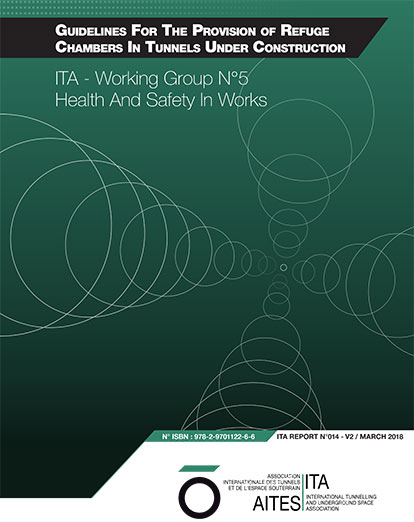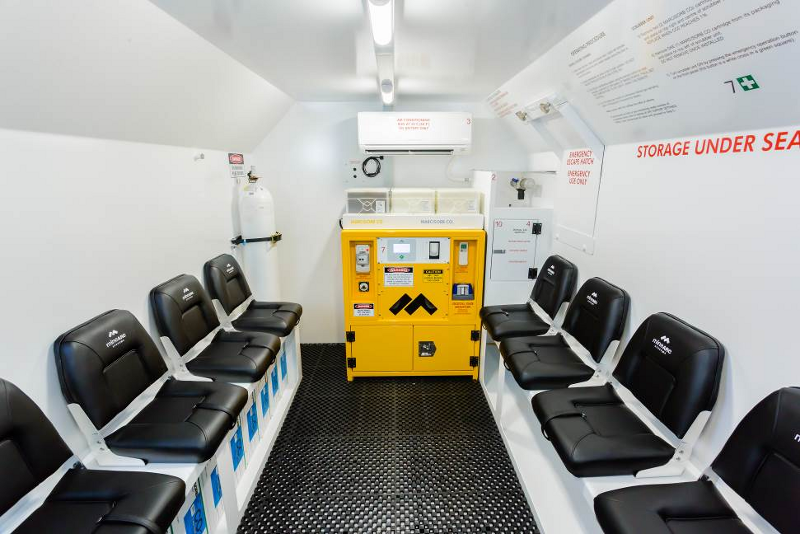-
Contribution from MineARC Africa
Mike Lincoln, General Manager of MineARC Africa confirms that the workers took refuge in a refuge bay supplied only with permanent fresh air and with no additional life support redundancies but that the mine does have MineSAFE Refuge Chambers and that MineARC Systems is working with the mine owner on a full risk assessment of all fresh air bays on site with the aim to bring the company’s emergency response protocol (ERP) up to globally-recognised safety standards. See the full contribution at the bottom of this article and on the Feedback page. To contribute to the discussion please use the Feedback entry form.
Integrity of ventilation in safety chamber
Very interesting article. Can someone please offer some thoughts on why ventilation pipes appear to have been damaged such that they fail to perform the function for which they were designed?
Sincerely,
Kevin GroverAll pipes that supply air to rescue chambers should be of a screwed thread type connection. The use of small bore clamped connections, with rubber seal inserts, could fail due to the heat, resulting in air loss at connections.
With regards,
Raymond Kryhul, MCD Group, UK
Feedback from ITA Working Group 5
Dr Donald Lamont, Animateur of ITA Working Group 5 on Health and Safety in Works warns that refuge chambers are complex pieces of equipment that must be equipped and operated correctly if they are to save lives. See the full Feedback contribution at the bottom of this article page and on the Feedback page and contribute to the discussion via our Feedback service.
Refuge chamber deaths raises concerns 26 Jul 2018
The fire that claimed the lives of six miners seeking safety in a refuge chamber in a South African copper mine recently, begs questions of how and why the disaster happened and what can be done to prevent future incidents.
Mining company Palabora said the incident occurred when an underground conveyer belt caught fire. When smoke was seen by a logistic belt operator the workers were reportedly instructed to evacuate the area to the closest refuge chamber.
The resident rescue team was reportedly not ready to complete the rescue, and a team from a neighbouring mine was called. This team took several hours to arrive and managed to recover one living and two deceased workers. High temperatures that rose to 67oC, made further rescue efforts impossible. The fire was reported to have been extinguished, but temperatures remained in excess of 50oC in areas. Protective clothing worn by rescuers slowed the rescue operation as it provided heat protection for a limited period of time only.
A further three miners were confirmed to have died in the refuge chamber.
It is reported that ventilation pipes to the refuge chamber had been damaged causing breathing difficulties for the occupants and communication lines were also compromised.

Guidelines for the provision of refuge chambers for civil tunnelling projects
Click to download a copy of the guidelines
Underground safety is a major concern, and particularly in South African mines where a number of deaths have been recorded already in 2018. Questions are now being asked as to how the workers died in a refuge chamber, what sort of refuge chamber is it, and how the chamber compares to rescue chambers being used and increasingly specified for worker safety on underground civil engineering projects.
A publication by Working Group 5 on Health and Safety in Works of the International Tunnelling and Underground Space Association (ITA) titled Guidelines For The Provision Of Refuge Chambers In Tunnels Under Construction states that a refuge chamber is a place of relative safety in a shaft or tunnel where tunnellers can be accommodated with access to basic life support services until rescued or it is safe for them to exit the tunnel.
It also states that a refuge chamber is not designed to protect against direct exposure to fire, hence in the event of a fire in the vicinity of the refuge chamber, tunnellers should not use the chamber but should evacuate the tunnel.
The differences between the logistics of deep mines and civil tunnelling environments are evident and while there have been miraculous underground rescues, including the rescue of the miners in Chile and more recently the group of young soccer players from the cave in Thailand, the safety of miners and crews working deep and long distances underground is paramount for the sustainability of the mining and the civil underground excavation industries as well as of the public when underground public infrastructure is opened for operation.
Further news will be published as information is received and as comments from industry are submitted. Please use the Feedback button at the bottom of the page to submit a contribution for publication in the Discussion Forum.
References
- Safety considerations for long Austrian headrace drives – TunnelTalk, December 2015
- Project growth fuels refuge chamber demand – TunnelTalk, June 2015
- Refuge chambers for Doha Metro TBMs – TunnelTalk, April 2014
- Monitoring for safety refuge chambers – TunnelTalk, June 2013
- Deluge fire control test for Seattle SR99 highway – TunnelTalk, July 2018
- Evacuating along elevated platforms – TunnelTalk, May 2018
- Effectiveness of sprinklers for fire suppression – TunnelTalk, August 2017
- Fatal collapse of metro heading in Foshan – TunnelTalk, February 2018
Feedback
Report of the situation that cased the deaths in South African mine
Report provided by: Mike Lincoln, General Manager, MineARC Africa
While the incident in the Limpopo mine following a conveyor belt fire on Sunday 15 July does not involve a MineARC Refuge Chamber, the Palabora Mining Company (PMC) has developed a strong working relationship with MineARC Systems and installed its first MineSAFE Refuge Chamber for PMC in 2013. MineARC Systems extends its heartfelt condolences to the families of those who lost their lives and to colleagues and the wider community affected by the incident. It is particularly unfortunate that the incident occurred at a site that continues to take proactive steps in improving their on-site safety and emergency response procedures.
Since installing its first MineSAFE Refuge Chamber for PMC in 2013, MineARC Systems has continued to work with PMC towards establishing a safe underground environment for all personnel, with the installation of further MineARC portable chambers that are supported by a diligent service and maintenance schedule.
Direct communication with the company indicated that the workers took refuge in a Lift 1 bay supplied only with permanent fresh air, as per the South African Department of Mineral Resources (DMR) Guidelines for Refuge Bays, and with no additional life support redundancies. Lift 2 at the Limpopo mine has three portable MineARC Refuge Chambers.
After the conveyor belt blaze erupted, three personnel made their way to one of the permanent fresh air bays. It has been reported that the compressed air supply to the shelter was compromised affecting the positive pressure of the bay. With no sealable door and a lack of any breathable air supply redundancy, gas detection or air-conditioning, a combination of overheating and smoke inhalation contributed to cause of death. High levels of CO and CO2, as well as a reading of 70°C temperatures, were detected inside the fresh air bay during the rescue attempt.
Unfortunately three additional workers, who were unable to make their way to a fresh air bay, also perished during the incident. It was also indicated that Lift 2 was not affected by smoke from the incident, however personnel utilised the MineARC Refuge Chambers at Lift 2 for a period of time as a precautionary measure before being evacuated.
The incident is under further investigation by the DMR.
Palabora Mining Company is compliant with the current South African safety regulations. MineARC Systems extends our heartfelt condolences to the families and to colleagues and the wider community affected by the fire.
For refuge bays however, and following this incident, PMC is already in the process of taking the necessary actions to avoid a similar outcome in future. This involves MineARC Systems conducting a full risk assessment of all fresh air bays on site with the aim to bring the company’s emergency response protocol (ERP) up to globally recognised safety standards.
Sincerely,
Mike Lincoln
General Manager, MineARC Africa
Integrity of ventilation in safety chamber
Very interesting article. Can someone please offer some thoughts on why ventilation pipes appear to have been damaged such that they fail to perform the function for which they were designed?
Sincerely,
Kevin Grover
All pipes that supply air to rescue chambers should be of a screwed thread type connection. The use of small bore clamped connections, with rubber seal inserts, could fail due to the heat, resulting in air loss at connections.
With regards,
Raymond Kryhul
MCD Group, UK
Warnings for the provision and use of refuge chambers
It is a tragedy that three men appear to have died in a refuge chamber. There is no indication whether death was due to excessive heat or to an irrespirable atmosphere.
Refuge chambers are complex pieces of equipment which must be equipped and operated correctly if they are to save lives. It is vitally important they are properly maintained and that all potential users are fully competent in their use. Otherwise an irrespirable atmosphere can build up in the chamber or the chamber can overheat and turn what is supposed to be a place of relative safety into a death trap.
The ITA Report 14, Clause 1.8, recommends that persons can remain in a refuge chamber for a minimum capability of 24 hours in a standalone, i.e. self-sufficient mode. In externally supported mode, the capability is much longer as the chamber is powered and supplied from the fixed installed tunnel supply lines.
Whilst this was a mining incident, the lessons from it should be taken on board by the tunnelling industry. The issues in question are fully covered in the ITA Report 14 Guidelines for the provision of refuge chambers in tunnels under construction.
Sincerely,
Dr Donald Lamont
Animateur ITA WG5
|
|
|
|
|
Add your comment
- Thank you for taking the time to share your thoughts and comments. You share in the wider tunnelling community, so please keep your comments smart and civil. Don't attack other readers personally, and keep your language professional.


